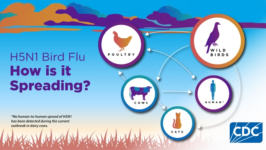
Bird Flu in Pets and Other Animals | Bird Flu
Background
Although bird flu viruses mainly infect and spread among wild migratory water birds and domestic poultry, some bird flu viruses can infect and spread to other animals as well. Bird flu viruses have in the past been known to sometimes infect mammals that eat (presumably infected) birds or poultry, including but not limited to wild animals, such as seals, bears, foxes, skunks; farmed mink; stray or domestic animals, such as cats and dogs; and zoo animals, such as tigers and leopards. H5N1 bird flu viruses have been detected sporadically in some domestic animals, including cats during outbreaks in Thailand in 2004, Northern Germany in 2006, and Poland and South Korea in 2023. Additionally, cases have been reported in cats, dogs, goat kids (juvenile goats), and dairy cows in North America. In December 2023, H5N1 virus infections were reported for the first time in mammals in both polar regions: an infected polar bear, which died in Alaska, and in elephant and fur seals in the Antarctic. While it’s very rare for people to be infected with bird flu viruses through contact with infected wild, stray, feral, or domestic mammals, it is possible—especially if there is prolonged and unprotected exposure to the animal. There have been two instances in the United States where bird flu virus spread from mammals to people, involving a cat in 2016 and a cow in 2024. This page provides information for different groups of people who might have direct contact with infected or potentially infected sick or dead animals, including animals that might have eaten or been exposed to bird flu-infected birds.
Pet Owners
If your domestic animals (e.g., cats or dogs) go outside and could potentially eat or be exposed to sick or dead birds infected with bird flu viruses, or an environment contaminated with bird flu virus, they could become infected with bird flu. While it’s unlikely that you would get sick with bird flu through direct contact with your infected pet, it is possible. For example, in 2016, the spread of bird flu from a cat to a person was reported in NYC. The person who was infected [2.29 MB, 4 pages] was a veterinarian who had mild flu symptoms after prolonged exposure to sick cats without using personal protective equipment.
If your pet is showing signs of illness compatible with bird flu virus infection and has been exposed to infected (sick or dead) wild birds/poultry, you should monitor your health for signs of fever or infection.
How to prevent spread
As a general precaution, people should avoid direct contact with wild birds and observe wild birds only from a distance, whenever possible. People should also avoid contact between their pets (e.g., pet birds, dogs and cats) with wild birds. Don’t touch sick or dead birds, their feces or litter, or any surface or water source (e.g., ponds, waterers, buckets, pans, troughs) that might be contaminated with their saliva, feces, or any other bodily fluids without wearing personal protective equipment (PPE). More information about specific precautions to take for preventing the spread of bird flu viruses between animals and people is available at Prevention and Antiviral Treatment of Bird Flu Viruses in People. Additional information about the appropriate PPE to wear is available at Backyard Flock Owners: Take Steps to Protect Yourself from Avian Influenza.
People Who Have Had Direct Contact with Infected or Potentially Infected Animals
During outbreaks of bird flu in wild birds and/or poultry, people who have had direct contact with infected or potentially infected animals, including sick animals that might have eaten bird flu-infected birds, should monitor their health for fever and symptoms of infection.
Signs and Symptoms may include:
- Fever (Temperature of 100°F [37.8°C] or greater) or feeling feverish/chills*
- Cough
- Sore throat
- Difficulty breathing/Shortness of breath
- Conjunctivitis (eye tearing, redness, irritation, or discharge from eye)
- Headaches
- Runny or stuffy nose
- Muscle or body aches
- Diarrhea
*Fever may not always be present
Call your state/local health department immediately if you develop any of these signs or symptoms during the 10-days after your exposure to an infected or potentially infected animal. Discuss your potential exposure and ask about testing. If testing is recommended, isolate as much as possible until test results come back and/or you have recovered from your illness.
Additionally, close contacts (family members, etc.) of people who have been exposed to a person or animal with lab-confirmed bird flu viruses should also monitor their health for 10 days after their exposure for signs and symptoms of illness. If close contacts of people who have been exposed to H5 bird flu viruses develop signs and symptoms of illness, they should also contact their state health department.
Handling Wildlife
If you find a sick or dead bird, check with your state health department, state veterinary diagnostic lab, or state wildlife agency on their policy for collecting dead animals and testing sick or dead animals.



